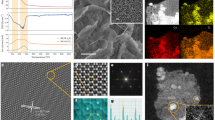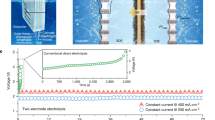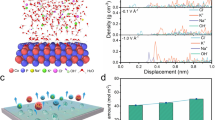Abstract
Seawater electrolysis powered by renewable electricity provides an attractive strategy for producing green hydrogen1,2,3,4,5. However, direct seawater electrolysis faces many challenges, primarily arising from corrosion and competing reactions at the anode caused by the abundance of halide ions (Cl−, Br−) in seawater6. Previous studies3,6,7,8,9,10,11,12,13,14 on seawater electrolysis have mainly focused on the anode development, because the cathode operates at reducing potentials, which is not subject to electrode dissolution or chloride corrosion reactions during seawater electrolysis11,15. However, renewable energy sources are intermittent, variable and random, which cause frequent start–shutdown operations if renewable electricity is used to drive seawater electrolysis. Here we first unveil dynamic evolution and degradation of seawater splitting cathode in intermittent electrolysis and, accordingly, propose construction of a catalyst’s passivation layer to maintain the hydrogen evolution performance during operation. An in situ-formed phosphate passivation layer on the surface of NiCoP–Cr2O3 cathode can effectively protect metal active sites against oxidation during frequent discharge processes and repel halide ion adsorption on the cathode during shutdown conditions. We demonstrate that electrodes optimized using this design strategy can withstand fluctuating operation at 0.5 A cm−2 for 10,000 h in alkaline seawater, with a voltage increase rate of only 0.5% khr−1. The newly discovered challenge and our proposed strategy herein offer new insights to facilitate the development of practical seawater splitting technologies powered by renewable electricity.
This is a preview of subscription content, access via your institution
Access options
Access Nature and 54 other Nature Portfolio journals
Get Nature+, our best-value online-access subscription
$32.99 / 30 days
cancel any time
Subscribe to this journal
Receive 51 print issues and online access
$199.00 per year
only $3.90 per issue
Buy this article
- Purchase on SpringerLink
- Instant access to full article PDF
Prices may be subject to local taxes which are calculated during checkout





Similar content being viewed by others
Data availability
The data that support the findings of this study have been included in the main text and the Supplementary Information.
Change history
13 March 2025
In the PDF version of this article initially published, images in panels in Fig. 2d, e, h were incomplete and are now updated in the online PDF.
References
Xie, H. et al. A membrane-based seawater electrolyser for hydrogen generation. Nature 612, 673–678 (2022).
Tong, W. et al. Electrolysis of low-grade and saline surface water. Nat. Energy 5, 367–377 (2020).
Kuang, Y. et al. Solar-driven, highly sustained splitting of seawater into hydrogen and oxygen fuels. Proc. Natl Acad. Sci. USA 116, 6624–6629 (2019).
Kosmala, T. et al. Operando visualization of the hydrogen evolution reaction with atomic-scale precision at different metal–graphene interfaces. Nat. Catal. 4, 850–859 (2021).
Lu, S.-Y. et al. Synthetic tuning stabilizes a high-valence Ru single site for efficient electrolysis. Nat. Synth. 3, 576–585 (2024).
Zhang, S. et al. Concerning the stability of seawater electrolysis: a corrosion mechanism study of halide on Ni-based anode. Nat. Commun. 14, 4822 (2023).
Shi, H. et al. A sodium-ion-conducted asymmetric electrolyzer to lower the operation voltage for direct seawater electrolysis. Nat. Commun. 14, 3934 (2023).
Hu, H., Wang, X., Attfield, J. P. & Yang, M. Metal nitrides for seawater electrolysis. Chem. Soc. Rev. 53, 163–203 (2024).
Duan, X. et al. Dynamic chloride ion adsorption on single iridium atom boosts seawater oxidation catalysis. Nat. Commun. 15, 1973 (2024).
Xu, W. et al. Ag nanoparticle-induced surface chloride immobilization strategy enables stable seawater electrolysis. Adv. Mater. 36, 2306062 (2024).
Kang, X. et al. A corrosion-resistant RuMoNi catalyst for efficient and long-lasting seawater oxidation and anion exchange membrane electrolyzer. Nat. Commun. 14, 3607 (2023).
Fan, R. et al. Ultrastable electrocatalytic seawater splitting at ampere-level current density. Nat. Sustain. 7, 158–167 (2024).
Xu, X. et al. Corrosion-resistant cobalt phosphide electrocatalysts for salinity tolerance hydrogen evolution. Nat. Commun. 14, 7708 (2023).
Liu, W. et al. Ferricyanide armed anodes enable stable water oxidation in saturated saline water at 2 A/cm2. Angew. Chem. Int. Ed. 62, e202309882 (2023).
Yang, F. et al. A durable and efficient electrocatalyst for saline water splitting with current density exceeding 2000 mA cm−2. Adv. Funct. Mater. 31, 2010367 (2021).
Beverskog, B. & Puigdomenech, I. Revised Pourbaix diagrams for chromium at 25–300 °C. Corros. Sci. 39, 43–57 (1997).
Dinh, C.-T. et al. Multi-site electrocatalysts for hydrogen evolution in neutral media by destabilization of water molecules. Nat. Energy 4, 107–114 (2019).
Gong, M. et al. Blending Cr2O3 into a NiO–Ni electrocatalyst for sustained water splitting. Angew. Chem. Int. Ed. 54, 11989–11993 (2015).
Peng, L. et al. Stabilizing the unstable: chromium coating on NiMo electrode for enhanced stability in intermittent water electrolysis. ACS Appl. Mater. Interfaces 14, 40822–40833 (2022).
Cherevko, S. et al. Dissolution of noble metals during oxygen evolution in acidic media. ChemCatChem 6, 2219–2223 (2014).
Li, T. et al. Atomic-scale insights into surface species of electrocatalysts in three dimensions. Nat. Catal. 1, 300–305 (2018).
Yu, K. et al. A sequential dual-passivation strategy for designing stainless steel used above water oxidation. Mater. Today 70, 8–16 (2023).
Li, T. et al. Phosphate-decorated Ni3Fe-LDHs@CoPx nanoarray for near-neutral seawater splitting. Chem. Eng. J. 460, 141413 (2023).
Hu, Y. et al. Understanding the sulphur-oxygen exchange process of metal sulphides prior to oxygen evolution reaction. Nat. Commun. 14, 1949 (2023).
Li, P. et al. Common-ion effect triggered highly sustained seawater electrolysis with additional NaCl production. Research 2020, 2872141 (2020).
Kresse, G. & Furthmüller, J. Efficiency of ab-initio total energy calculations for metals and semiconductors using a plane-wave basis set. Comput. Mater. Sci. 6, 15–50 (1996).
Kresse, G. & Furthmüller, J. Efficient iterative schemes for ab initio total-energy calculations using a plane-wave basis set. Phys. Rev. B 54, 11169–11186 (1996).
Kresse, G. & Joubert, D. From ultrasoft pseudopotentials to the projector augmented-wave method. Phys. Rev. B 59, 1758–1775 (1999).
Blöchl, P. E. Projector augmented-wave method. Phys. Rev. B 50, 17953–17979 (1994).
Henkelman, G. & Jónsson, H. Improved tangent estimate in the nudged elastic band method for finding minimum energy paths and saddle points. J. Chem. Phys. 113, 9978–9985 (2000).
Henkelman, G., Uberuaga, B. P. & Jónsson, H. A climbing image nudged elastic band method for finding saddle points and minimum energy paths. J. Chem. Phys. 113, 9901–9904 (2000).
Perdew, J. P., Burke, K. & Ernzerhof, M. Generalized gradient approximation made simple. Phys. Rev. Lett. 77, 3865 (1996); erratum 78, 1396 (1997).
Acknowledgements
We acknowledge H. Dai and Y. Kuang for the helpful guidance, L. Gu, T. Zhang and Y. Lu for the help on HAADF-STEM characterization and D. Lu for the help on TOF-SIMS characterization. X.S. and D.Z. acknowledge financial support from the National Key Research and Development Project (2022YFA1504000), the National Natural Science Foundation of China (21935001), Beijing Natural Science Foundation (Z210016), a long-term subsidy from China’s Ministry of Finance and the Ministry of Education. D.Z. acknowledges financial support from the Young Elite Scientists Sponsorship Program by CAST (2022QNRC001). B.L. acknowledges financial support from the City University of Hong Kong startup fund (9020003), ITF-RTH-Global STEM Professorship (9446006) and JC STEM lab of Advanced CO2 Upcycling (9228005).
Author information
Authors and Affiliations
Contributions
X.S., B.L. and D.Z. supervised the project. Q.S. and S.W. conceived the idea and carried out the experiments and also conducted materials synthesis and electrochemical measurements. Q.S. wrote the paper. X.G., T.L. and Z. Zhuang helped with the anion exchange membrane test. L.Y., S.L. and X.G. helped with the stability test. H.L., Y.F. and Z. Zhang performed the density functional theory calculations.
Corresponding authors
Ethics declarations
Competing interests
The authors declare no competing interests.
Peer review
Peer review information
Nature thanks Xiaoqiang Du and the other, anonymous, reviewer(s) for their contribution to the peer review of this work.
Additional information
Publisher’s note Springer Nature remains neutral with regard to jurisdictional claims in published maps and institutional affiliations.
Supplementary information
Rights and permissions
Springer Nature or its licensor (e.g. a society or other partner) holds exclusive rights to this article under a publishing agreement with the author(s) or other rightsholder(s); author self-archiving of the accepted manuscript version of this article is solely governed by the terms of such publishing agreement and applicable law.
About this article
Cite this article
Sha, Q., Wang, S., Yan, L. et al. 10,000-h-stable intermittent alkaline seawater electrolysis. Nature 639, 360–367 (2025). https://doi.org/10.1038/s41586-025-08610-1
Received:
Accepted:
Published:
Issue date:
DOI: https://doi.org/10.1038/s41586-025-08610-1
This article is cited by
-
Direct seawater electrolysis for hydrogen production
Nature Reviews Materials (2025)
-
Engineered PW12-polyoxometalate docked Fe sites on CoFe hydroxide anode for durable seawater electrolysis
Nature Communications (2025)
-
Electrolyzer engineering through in situ catalyst regeneration
Nature Chemical Engineering (2025)
-
Metal–organic-framework-based electrolyzers with mass appeal
Nature Chemical Engineering (2025)
-
Rare earth engineering to mitigate corrosion challenges in seawater electrolysis
Frontiers in Energy (2025)



